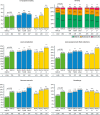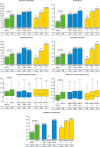Metabolic-associated fatty liver disease is associated with acute pancreatitis with more severe course: Post hoc analysis of a prospectively collected international registry
- PMID: 37062947
- PMCID: PMC10165320
- DOI: 10.1002/ueg2.12389
Metabolic-associated fatty liver disease is associated with acute pancreatitis with more severe course: Post hoc analysis of a prospectively collected international registry
Abstract
Introduction: Non-alcoholic fatty liver disease (NAFLD) is a proven risk factor for acute pancreatitis (AP). However, NAFLD has recently been redefined as metabolic-associated fatty liver disease (MAFLD). In this post hoc analysis, we quantified the effect of MAFLD on the outcomes of AP.
Methods: We identified our patients from the multicentric, prospective International Acute Pancreatitis Registry of the Hungarian Pancreatic Study Group. Next, we compared AP patients with and without MAFLD and the individual components of MAFLD regarding in-hospital mortality and AP severity based on the revised Atlanta classification. Lastly, we calculated odds ratios (ORs) with 95% confidence intervals (CIs) using multivariate logistic regression analysis.
Results: MAFLD had a high prevalence in AP, 39% (801/2053). MAFLD increased the odds of moderate-to-severe AP (OR = 1.43, CI: 1.09-1.89). However, the odds of in-hospital mortality (OR = 0.89, CI: 0.42-1.89) and severe AP (OR = 1.70, CI: 0.97-3.01) were not higher in the MAFLD group. Out of the three diagnostic criteria of MAFLD, the highest odds of severe AP was in the group based on metabolic risk abnormalities (OR = 2.68, CI: 1.39-5.09). In addition, the presence of one, two, and three diagnostic criteria dose-dependently increased the odds of moderate-to-severe AP (OR = 1.23, CI: 0.88-1.70, OR = 1.38, CI: 0.93-2.04, and OR = 3.04, CI: 1.63-5.70, respectively) and severe AP (OR = 1.13, CI: 0.54-2.27, OR = 2.08, CI: 0.97-4.35, and OR = 4.76, CI: 1.50-15.4, respectively). Furthermore, in patients with alcohol abuse and aged ≥60 years, the effect of MAFLD became insignificant.
Conclusions: MAFLD is associated with AP severity, which varies based on the components of its diagnostic criteria. Furthermore, MAFLD shows a dose-dependent effect on the outcomes of AP.
Keywords: MAFLD; NAFLD; acute pancreatitis; metabolic syndrome; metabolic-associated fatty liver disease; mortality; non-alcoholic fatty liver disease; prognosis; severity; steatosis.
© 2023 The Authors. United European Gastroenterology Journal published by Wiley Periodicals LLC on behalf of United European Gastroenterology.
Conflict of interest statement
The authors do not have any conflicts of interest to declare.
Figures



Comment in
-
Fatty liver disease and pancreatic inflammation-A lethal combination?United European Gastroenterol J. 2023 Jun;11(5):405-406. doi: 10.1002/ueg2.12400. Epub 2023 May 11. United European Gastroenterol J. 2023. PMID: 37169595 Free PMC article. No abstract available.
References
-
- Xiao AY, Tan ML, Wu LM, Asrani VM, Windsor JA, Yadav D, et al. Global incidence and mortality of pancreatic diseases: a systematic review, meta‐analysis, and meta‐regression of population‐based cohort studies. Lancet Gastroenterol Hepatol. 2016;1(1):45–55. 10.1016/s2468-1253(16)30004-8 - DOI - PubMed
-
- IAP/APA evidence‐based guidelines for the management of acute pancreatitis. Pancreatology. 2013;13(4 Suppl 2):e1–e15. - PubMed
MeSH terms
LinkOut - more resources
Full Text Sources
Medical

